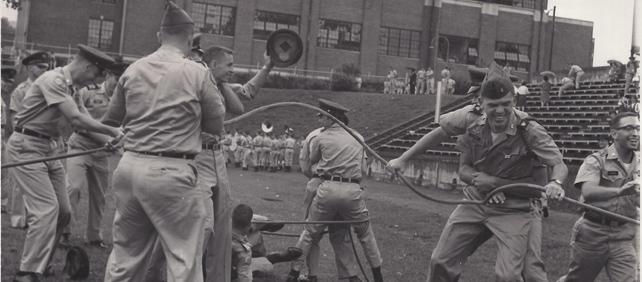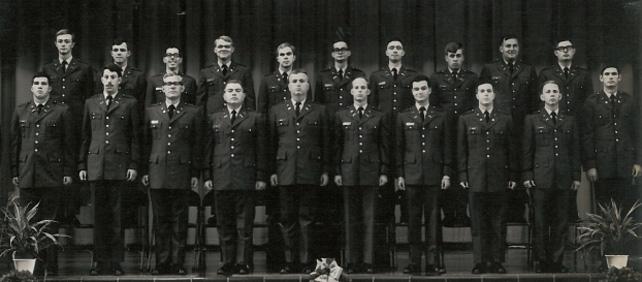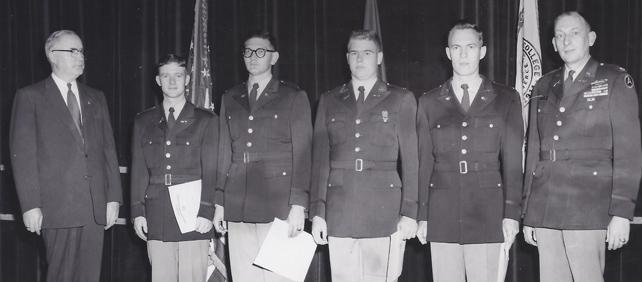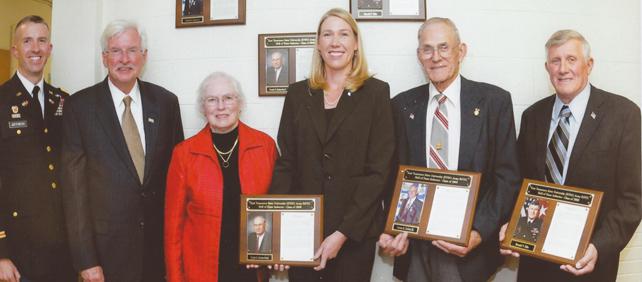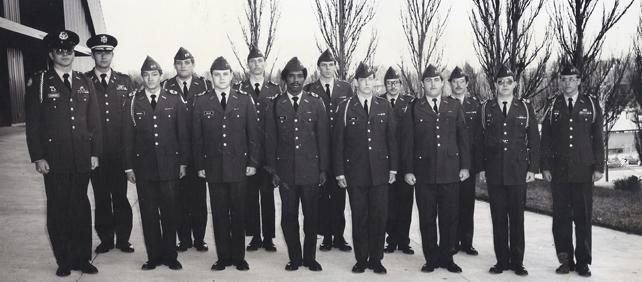History of ROTC
History of the Army ROTC Program
The origins of the Army ROTC program may be traced to the early 19th Century. In 1819, through the efforts of Captain Alden Partridge, the American Literary, Scientific and Military Academy known today as Norwich University was foiunded. It was there that training in military tactics was first offered as a component of the curriculum of a civilian college in America. Under this concept, colelge-educated men would receive a strong foundation in military tactics. During times of national crisis, these "citizen-soldiers" would be available for service in the militia. The Morrill Act of 1862 spurred additional availability of military training on American college campuses. Enacted during the Civil War, the Morrill Act provided federal lands to state-supported colleges provided that training in military tactics was available.
The Army ROTC program, as we know it today, came into being with the passage of the National Defense Act of 1916. Many fine academic institutions, including the University of California-Berkeley and Norwich University were part of this initial cohort. This represented the first time that military instruction on America's college campuses was brought under a single, federally-controlled program. A total of approximately 50,000 men, who had received some form of military instruction on a college campus, ultimately were to serve during the First World War. During School Year 1919-1920, the Army ROTC program produced its first group of lieutenants. These 133 new officers were to be joined by more than 500,000 other by 1985.
During the Second World War 150,000 ROTC-trained officers played an integral role in the defeat of the Axis Powers. And 18,000 officers, who also got their start in the Army ROTC program, answered the call to arms during the Korean Conflict. By the height of the Cold War, Army ROTC had proven itself as one of the nation's principal sources of top quality leaders. This led to the passage of the ROTC Vitalization Act of 1964. One key provision of that legislation formed the basis for the very popular Army ROTC scholarship program. Throughout the Vietnam Conflict, Army ROTC-trained officers served at every level of command in our Army.
In 1972, previous restrictions that prohibited full participation by women in Army ROTC were lifted. But perhaps the most significant change to the Army ROTC program since its inception in 1916 was to occur in 1986. In April of that year, U.S. Army Cadet Command was established. Its initial commander, Major General Robert E. Wagner, himself a graduate of the Army ROTC program at Virginia Military Institute, set about to reinvigorate the program and bring enhanced rigor into the training and leadership evaluation process.
In 2006, Cadet Command celebrated the 20th anniversary of its founding. Since being established as a major subordinate command of U.S. Army Training and Doctrine Command (TRADOC), Cadet Command has produced more than 100,000 lieutenants for America's Army. Graduates of the ROTC program currently comprise more than 50% of the General Officers on Active Duty in the Army. And countless senior leaders in the corporate sector and in government proudly note that the Army ROTC program gave them the leadership and managerial skills that have allowed them to flourish in their civilian careers.
Buc Battalion History
The Reserve Officers' Training Corps was established by the National Defense Act of 1916 to train men on college campuses for commissioning. However, the campaign to establish a Senior ROTC detachment at East Tennessee State College was by no means an easy task. In early 1950, University President Dr. C. C. Sherrod was invited by the Commanding General of Third Army to attend a regional ROTC conference at Georgia Tech, to address ROTC within the schools that made up the Tennessee College Association.
With the outbreak of the Korean War, the Georgia Tech conference was cancelled. Dr. Burgin Dossett, however, who had succeeded Dr. Sherrod as ETSC's president, immediately began a personal quest to establish a ROTC unit at East Tennessee State College. Dr. Dossett wrote to Colonel W. I. Sherwood, Chief of the Tennessee Military District, explaining that the facilities at East Tennessee State College were indeed adequate to accommodate a ROTC department. Following a favorable inspection, four Tennessee schools were recommended for consideration: Memphis State Teachers College, Vanderbilt University, Austin Peay College, and East Tennessee State College.
In November 1950, Dossett received a letter from the Commanding General of the Third Army requesting that East Tennessee State College formally apply for a Senior ROTC unit. Unfortunately, when the board met two months later, East Tennessee State College was not one of the 36 schools selected from the 275 applicants.
In February 1951, Dossett applied for an Air Force ROTC unit but was again turned down. However, Dr. Dossett refused to give up. One year later, after a second application to Third Army, an Army ROTC unit was assigned to East Tennessee State College on May 12, 1952. The program was made mandatory for all physically qualified male freshmen.
In 1953, East Tennessee State College held its first commissioning ceremony. Since that time, ETSU ROTC has commissioned over 1,600 men and women as U.S. Army second lieutenants. These great Americans have served our nation well, and are a testament to the consistently outstanding ROTC program here at ETSU.
To date, eleven of these commissionees have achieved the rank of Army general officer:
- Brigadier General Jere Hickman, class of '55
- Brigadier General Billy J. Stalcup, class of '57
- Major General Ronald Brooks, class of '61
- Major General Dennis V. Crumley, class of '61
- Lieutenant General Hubert Smith, class of '62
- Lieutenant General Ronald Hite, class of '64
- Major General Gary Harrell, class of '72
- Brigadier General Isaac G. Osborne, class of '74
- Brigadier General William Alexander, Jr., class of '68
- Brigadier General Rodney Fogg, class of '87
- Brigadier General Michael T. Harvey, class of '91
A number of other ETSU ROTC alumni have given their lives while serving in the United States Army on active duty. Nine of these alumni died in the Vietnam Conflict, one during Desert Storm.
- Captain Alvin K. Broyles, 28 April 1965
- Captain Donald J. Fillers, 28 May 1965
- Captain Eugene D. Franklin, 24 June 1965
- Major Billy J. Nave, 27 June 1966
- First Lieutenant Douglas L. Jones, 12 October 1966
- Captain Gordon O. Walsh, 16 April 1967
- First Lieutenant Daniel L. Mullins, 31 August 1967
- Captain James E. Reed, 1 February 1968
- First Lieutenant James D. Dugger, 16 October 1972
- Captain Daniel E. Graybeal, 27 February 1991
Over the last six decades, ROTC at ETSU has produced consistently outstanding young officers, while changing with the times to remain current. In 1953, the Sponsor Corps was formed to enable females to be a part of the ROTC program. Eleven years later, in 1964, Military Science became an approved minor. During the turbulent 70's, following significant protests on campus, the administration made ROTC a voluntary program. This last change mirrored the Army's move to an all-volunteer force, and while the size of the program decreased, the quality of the Cadet corps has remained high.
Today's Cadets are actively involved in numerous ROTC and other campus organizations, including the Pershing Rifles drill and ceremony team, Scabbard and Blade national honor society, Presidents Pride, the ETSU ROTC running club, and the Eddie Reed Ranger Company. Established in the early 1970s, the Ranger Company continues to train Cadets on advanced techniques beyond the standard Military Science curriculum; team members also represent ETSU at various regional Ranger Challenge competitions. Our Rangers have developed a reputation for displaying exceptional professionalism, dedication to excellence and the desire to lead by example.
As we look back over the past 60-plus years, ETSU's Army ROTC program has not only been a source of outstanding officers for the United States Army, but a highly successful academic department within the College of Business and Technology, and a valuable contributor to ETSU and the local community. Today's Battalion Cadets continue to train and prepare for challenging careers in the service of our Nation, while the skills they develop in ROTC allow our alumni to be successful as Army officers and civilian leaders. Building on a strong tradition of excellence and continued growth in Cadet numbers, the future looks bright for ETSU Army ROTC.
 Stout Drive Road Closure
Stout Drive Road Closure 